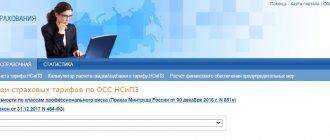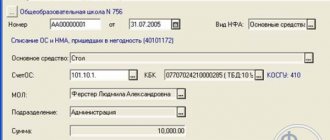According to what standard is a camera taken into account in 2022?
As a general rule, to determine the depreciation group, first find the fixed asset in OKOF and find out which code corresponds to it. Then find this code in the Classification and determine which depreciation group it belongs to.
- the first three characters are the type of fixed assets (for example, for non-residential buildings the code starts with 210);
- the remaining signs correspond to codes from the All-Russian Classifier of Products by Type of Economic Activity - OKPD2 OK 034-2014 KPES 2008 (approved by order of Rosstandart dated January 31, 2014 No. 14-st).
Instead of OK Classification of fixed assets included in depreciation groups, approved by Decree of the Government of the Russian Federation dated January 1.
The basis for the development of the All-Russian Classifier of Fixed Assets is the Action Plan for developing a methodology for systematizing and coding information, as well as improving and updating all-Russian classifiers, registers and information resources, approved by Deputy Chairman of the Government of the Russian Federation A.
All rights reserved. Violation of copyright entails liability in accordance with the legislation of the Russian Federation. To ensure the quality of materials and protect the copyright of the editors, many articles on our website are in closed access.
Two urgent changes in the work of an accountant and five important things to do before the end of the summer.
And also Articles on the topic Which depreciation group does a passenger car belong to? Depreciation groups of fixed assets. Methods for calculating depreciation. Depreciation in the balance sheet. Accelerated depreciation.
Accounting for photographic and film equipment
- If one structurally articulated object has several parts - fixed assets that have different useful lives, each such part must be accounted for as an independent inventory item. That is, each part of a structurally articulated object that has a different useful life should be assigned a separate inventory number;
- If a complex has structurally articulated objects, consisting of several objects, for which a useful life period common to all objects is established, all parts of the specified object must be taken into account as an independent inventory object. That is, in this case, all objects of a complex of structurally articulated objects will be assigned one inventory number.
We recommend reading: Amendments to Article 228 Part 31 of 2022 Will be
In order to determine the initial cost of equipment when purchased for a fee, the institution's actual investments are formed taking into account the VAT amounts presented to the institution by suppliers (except for the acquisition of an object within the framework of the institution's activities, subject to VAT, unless otherwise provided by the tax legislation of the Russian Federation).
There are legally approved Lists that list tax-exempt property codes. Based on this data, enterprises analyze their facilities and decide on tax minimization.
- items that last less than a year;
- special tools and devices (for mass production);
- workwear, uniforms and footwear issued to employees;
- young animals, poultry, rabbits, bee families, etc.;
- temporary structures erected during construction;
- perennial plantings and planting material;
- gasoline-powered saws, loppers, etc.;
- temporary forest structures;
- items that are rented (regardless of their cost).
, N 11 (brief) “Information on the availability and movement of fixed assets (funds) of non-profit organizations” In accordance with OKOF, communication system equipment includes: terminal devices (transmitting and receiving), devices of switching systems - stations, nodes used for transmitting any type of information (speech, alphanumeric, visual, and so on) by signals distributed through wires, optical fibers, or radio signals, that is, telephone, telegraph, fax, telecode communication equipment, cable radio and television broadcasting.
SNA 2008 OKOF Alphanumeric designation Name of types of fixed assets Code Name of types of fixed assets AN 111 Residential buildings 100 Residential buildings and premises AN 112 Other buildings and structures 200 Buildings (except residential) and structures, expenses for land improvement AN 1121 Non-residential buildings 210 Buildings (except residential) AN 1122 Other structures 220 Structures AN 1123 Land improvements 230 Land improvement expenses AN 113 Plant and equipment 300 Plant and equipment, including household implements, and other objects
street camera OKOF 2022 shock-absorbing group
Therefore, instead of the whole system, accounting should reflect individual items of equipment that are part of it and meet the criteria for classification as fixed assets formulated in paragraphs 38, 39, 45 of Instruction No. 157n and paragraphs.
Depreciation is calculated based on the useful life of a fixed asset, which is determined using a classifier in which objects are combined into depreciation groups. This classifier contains an object code, a decoding of this code with the name of the object and a note.
Okof video surveillance system 2020
The useful life of an asset (fixed asset) is one of the main indicators necessary when determining the amount of depreciation.
Depending on the useful life (SPI), the asset is included in one or another depreciation group in tax accounting (Clause 1, Article 258 of the Tax Code of the Russian Federation).
We will tell you in our consultation which depreciation group the video surveillance system belongs to in tax accounting, as well as what period for such an object can be set in accounting.
Source: https://nl-consalting.ru/oformlenie-razvoda/po-kakomu-okof-uchityvaetsya-fotokamera-v-2019-godu
Service life of CCTV camera
- the expected life of the facility in accordance with its expected productivity or capacity;
- expected physical wear and tear, depending on the operating mode (number of shifts), natural conditions and the influence of an aggressive environment, the repair system;
- regulatory and other restrictions on the use of this object (for example, rental period).
Rationale for the conclusion: The procedure for classifying operations of the general government sector (KOSGU) is established by Section V of the Instructions on the procedure for applying the budget classification of the Russian Federation, approved by Order of the Ministry of Finance of Russia dated July 1, 2013 N 65n (hereinafter referred to as Instructions N 65n). They indicate that: - Article 310 “Increase in the cost of fixed assets” of KOSGU includes expenses for payment of contracts for the acquisition of objects related to fixed assets, as well as for reconstruction, technical re-equipment, expansion, modernization (modernization with additional equipment) of fixed assets; — for article 340 “Increase in the cost of inventories” of KOSGU expenses for payment of contracts for the purchase of objects related to inventories. Thus, when determining the KOSGU for payment for a non-financial asset (in this case, this is a webcam), it is necessary to determine the final purpose of the purchase being made. In this case, the web camera can be accounted for in accounting as: - a separate inventory item of fixed assets; — material value purchased for the purpose of retrofitting a previously acquired fixed asset (computer); — material stock. The decision to classify the purchased property as one or another group of non-financial assets is made by the commission for the receipt and disposal of the institution’s assets (clause 34 of Instruction No. 157n). In her work, she is guided by the norms of Instruction No. 157n, as well as the federal accounting standard for public sector organizations “Fixed Assets”, approved by Order of the Ministry of Finance of Russia dated December 31, 2016 N 257n (hereinafter referred to as GHS “Fixed Assets”). In this case, the assignment of property: - to fixed assets is carried out when the criteria listed in paragraphs are met. 38, 39 Instructions No. 157n, pp. 7, 8 GHS “Fixed assets”; — to material reserves in accordance with the requirements of clause 99 of Instruction No. 157n. A webcam, as a non-financial asset, is a device designed to capture an image in real time and then transmit it over computer networks. To operate a webcam on a computer network, as a rule, it is not necessary to use special devices. The obtained information can be viewed on any technical device designed to work with images in digital format used by a webcam. This can be a separate computer or a group of computers connected by a network, and also, depending on the technical parameters, the webcam itself. If, when making a decision, the specialized commission of the institution establishes that the purchased webcam: - meets the criteria for being classified as a separate inventory accounting object, that is, in the economic activities of the institution it will be used as an independent device, maybe even attached to another non-financial asset (fixed asset or some other something that is an integral part of the fixed asset), but is not inextricably linked with it; - the useful life will be more than 12 months, then a well-founded decision can be made to account for the web camera as an independent object as part of fixed assets. Such an economic situation is subject to reflection under Article 310 “Increase in the value of fixed assets” of KOSGU. If the specialized commission of the institution concludes that the webcam is a “new” additional information input device for a computer device installed at the institution’s cash desk, and at the same time improves its quality or technical characteristics, then the purchase in question can be classified as retrofitting an existing main one facilities. Then the costs of purchasing a webcam will have to increase the cost of the originally purchased property (computer) (clause 19 of the GHS “Fixed Assets”, paragraph 2 of clause 27 of Instruction No. 157n). In this case, if the institution concludes an agreement for the modernization (modernization with additional equipment) of a specific computer, then the costs should be charged for accounting purposes under Article 310 “Increase in the cost of fixed assets” of KOSGU. At the same time, if the purchased cameras are components for upgrading a fixed asset (computer) in an economic way, their payment should be reflected in accounting under Article 340 “Increase in the cost of inventories” of KOSGU. Using this article, expenses should also be reflected in the event that the specialized commission of the institution decides to take cameras into account as part of material reserves when establishing the useful life of a webcam for less than 12 months. It should also be noted that any decision to classify material assets into the appropriate group of non-financial assets is subjective and is based on the professional judgment of specific officials of the institution in which the property will be used, taking into account the technical characteristics, specifics and expected operating conditions of the objects. Moreover, specialists from the financial department also indicate in their explanations that such decisions fall exclusively within the competence of government agency employees who have complete and reliable information necessary for their adoption (see, for example, letters of the Ministry of Finance of Russia dated November 11, 2013 N 02-06- 010/48099, dated 02/27/2012 N 02-07-10/534). This principle has not changed even after the federal standards came into force.
13 Jan 2022 lawurist7 693
Share this post
- Related Posts
- How to get a labor veteran of the Udmurt Republic in 2020
- Category of Citizens Having the Right to Ride Free Transport in Omsk
- Law on Tishen Irkutsk
- Benefits for Labor Veterans of Federal Significance in 2022 in the Novgorod Region
OKOF recorder: depreciation group, code, automobile, new
The OKOF registrar classifies it as depreciation group 4. The All-Russian Classifier of Fixed Assets (OKOF) is used to simplify the accounting of machinery and equipment at an enterprise or for individuals.
Which group does Okof include DVRs in?
As mentioned above, according to the all-Russian classification, video surveillance cameras are assigned depreciation group 4, subject to stable income (profit) from purchased equipment and the cost of the equipment exceeding 40,000 rubles.
For each depreciation group in 2022, OKOF distributed the useful life of equipment in accordance with Article 258 of the Tax Code of the Russian Federation. The useful life is determined by the owner himself.
The taxpayer indicates the end date of useful operation of the equipment independently.
If the purchased device is not included in the classifier list, then the buyer selects the end date of the device, relying on the manufacturer’s advice and operating instructions.
If the technical characteristics of the purchase do not indicate the approximate service life, then you should contact the dealers, explain the current situation and assign your purchase a code number in accordance with the classification.
Depreciation of DVRs
cameras can fall into different categories. For example, it is believed that a camera for protecting premises can serve as a camera for testing grounds or making films. But then such equipment can be classified as depreciation group 5, in which the useful life will be from 7 to 10 years.
At the same time, the 9th Arbitration Court of Appeal ruled on March 1, 2011 that video recorders used to protect premises cannot be used for testing purposes or used for filming films. In this case, this equipment should be classified as depreciation class 3.
In such a situation, the camera owner can use the manufacturer’s recommendations for technical operation.
But for DVRs of this type, the all-Russian classifier has not established a specific depreciation group, which is why they are classified as fourth. The useful life is 5-7 years from the date of purchase. A new code OKOF 14 3230000 “Television and radio receiving equipment” or code OKOF 14 3221137 “Video recording and playback equipment for general use” is assigned.
The depreciation group and useful life of the purchased camera are confirmed by a local document: a deed, order or order signed and sealed by the director of the organization.
Before starting work, the equipment goes through an accounting procedure, where it is assigned its own number at this particular enterprise, and the useful service life is determined.
In connection with Resolution No. 20 PBU 6/01 “Accounting for fixed assets”, an organization can determine the useful life independently. It will depend on many factors:
- capacity and productivity of the facility;
- its wear, which, in turn, depends on how it is used, how many times it is repaired and whether preventive maintenance is carried out to extend its service life;
- legal regulations that may limit the use of the equipment (for example, if the DVR is rented).
At the same time, the accounting department of any enterprise will not take on unnecessary problems, especially since the All-Russian Classifier of Fixed Assets has long been compiled in the Russian Federation. In addition, the useful life of the classification is designed in such a way that there is practically no difference between accounting and tax accounting. Therefore, it is customary to set the service life of equipment in accordance with OKOF.
OKOF code 330.26.70 is assigned to optical devices and photographic equipment - depreciation group 3. This is a general point for all DVRs.
330.26.70.1 - OKOF code for photographic equipment, depreciation group 4. This group includes codes 330.26.70.12-330.26.70.18, including:
- cameras for printing documents and recording on removable media;
- digital photo and video cameras;
- cameras with instant image acquisition;
- film cameras and projectors;
- laboratory tools for photographer (videographer);
- main devices for reading information from removable micromedia.
Classification code 330.26.70.2 - optical and other instruments. This class includes optical instruments, such as binoculars, lenses, mirrors, prisms, microscopes and other complex devices. They are assigned depreciation group 3.
Source: https://MoyoAuto.ru/videoregistrator/okof.html
Depreciation groups of fixed assets in 2022: how to determine according to OKOF
The organization determines the useful life of a fixed asset in order to calculate depreciation in accounting and tax accounting. From May 12, 2022, accountants will apply the updated Classification of Property, Plant and Equipment. Let us tell you in more detail what has changed and how to determine depreciation groups in 2022.
Express courses
Intensives on hot topics at Kontur.School
Schedule
Fixed assets (FPE) of an organization, depending on their useful life (SPI), for profit tax purposes are assigned to one or another depreciation group (Clause 1, Article 258 of the Tax Code of the Russian Federation). The useful life of the OS is determined by the organization itself, taking into account the classification approved by Decree of the Government of the Russian Federation of January 1, 2002 No. 1 (Resolution No. 1).
In 2022, all depreciation classification groups have changed, except the first. The changes apply to legal relations arising from January 1, 2022.
Most of the amendments are in the subsection “Structures and transmission devices” of the second to tenth groups. The list of fixed assets in the “Machinery and Equipment” subsection of the second and ninth groups has been expanded.
Classifier of fixed assets by depreciation groups with examples of fixed assets:
Depreciation group number Useful life of fixed assets Example of fixed assets belonging to the depreciation group
| 1 | From 1 year to 2 years inclusive | General purpose machinery and equipment |
| 2 | Over 2 years up to 3 years inclusive | Liquid pumps |
| 3 | Over 3 years up to 5 years inclusive | Radio-electronic communications |
| 4 | Over 5 years up to 7 years inclusive | Fences (fences) and reinforced concrete barriers |
| 5 | Over 7 years up to 10 years inclusive | Forest industry buildings |
| 6 | Over 10 years up to 15 years inclusive | Water intake well |
| 7 | Over 15 years up to 20 years inclusive | Sewerage |
| 8 | Over 20 years up to 25 years inclusive | Main condensate and product pipelines |
| 9 | Over 25 years up to 30 years inclusive | Buildings (except residential) |
| 10 | Over 30 years | Residential buildings and structures |
The All-Russian Classifier of Fixed Assets (OKOF), which determines the depreciation group of fixed assets, remains unchanged. Since January 1, 2017, OKOF OK 013-2014 (SNS 2008), approved by Rosstandart order No. 2018-st dated December 12, 2014, has been in effect. The same classifier will be in effect in 2022.
Stage 1 - establish the depreciation group of the fixed asset according to the classification approved by Resolution No. 1
The classification of fixed assets is a table in which, for each depreciation group, the names of the fixed assets included in it and the corresponding codes of the All-Russian Classifier of Fixed Assets are listed.
For tax accounting purposes, according to the classification of fixed assets, the following is determined:
- depreciation group to which the fixed asset belongs. All depreciable property is combined into 10 depreciation groups depending on the useful life of the property (clause 3 of Article 258 of the Tax Code of the Russian Federation). Depreciation groups are also important in determining the amount of depreciation bonus that can be applied to a specific asset;
- the useful life must be within the limits established for each depreciation group (Letter of the Ministry of Finance of Russia dated July 6, 2016 No. 03-05-05-01/39563). Choose any period within the SPI, for example the shortest, in order to quickly write off the cost of the fixed assets as expenses (Letter of the Ministry of Finance of the Russian Federation dated July 6, 2016 No. 03-05-05-01/39563).
You can set an entire OS group in the classification. A transcript of the group is presented in OKOF.
Define the depreciation group of the fixed asset as follows:
- In the first column of OKOF, find the type of property to which the OS belongs (9 digits).
- Check the code specified in the OKOF in the first column of the OS classification.
- If there is a code in the OS classification, look at which depreciation group the OS belongs to.
If there is no code in the OS classification, determine the depreciation group in one of the following ways:
Method 1 - by property subclass code
The property subclass code differs from the property type code in that the seventh digit in it is always zero. For example, a rotary pump belongs to subclass 14 2912010 (centrifugal, piston and rotary pumps). If this code is not included in the OS classification, determine the depreciation group using the second method.
Method 2 - by property class code
The property class differs from the property type code in that the seventh, eighth and ninth digits in it are always zeros. For example, a rotary pump belongs to class 14 2912000 (pumps and compressor equipment).
Example . Determination of depreciation group using OKOF code
The rotary pump code according to OKOF is 14 2912113. In the OS Classification, such a code, as well as subclass code 14 2912010 (centrifugal, piston and rotary pumps) are not indicated.
However, it contains class code 14 2912000 (pumps and compressor equipment). It belongs to the third depreciation group (property with a useful life of more than three years up to five years inclusive).
This means that the rotary pump must be included in the third shock-absorbing group.
Step 2: Consult technical documentation
If the fixed asset is not mentioned in the classification and OKOF, establish the SPI from the operating life of the OS specified in the technical documentation or manufacturer’s recommendations (clause 6 of Article 258 of the Tax Code of the Russian Federation, Letter of the Ministry of Finance of Russia dated June 18, 2018 No. 03-03-20/41332) .
Stage 3. Record the SPI in the asset accounting inventory card (Form No. OS-6)
If the tax and accounting SPI are different, then add section 2 of form No. OS-6 with the corresponding column.
Example. The organization purchased a Gazelle cargo truck (carrying capacity 1.5 tons). Let's determine the SPI of the car.
According to the OS classification, general purpose trucks with a carrying capacity of over 0.5 and up to 5 tons inclusive are included in the 4th depreciation group.
The SPI range for the 4th depreciation group is over 5 and up to 7 years inclusive. Therefore, the minimum possible SPI in months is 61 (5 years x 12 months + 1 month), the maximum is 84 months. (7 years x 12 months).
The organization has the right to establish any vehicle SPI in the range from 61 to 84 months inclusive.
Please note when accounting for OS
- In tax accounting, the cost criterion for recognizing an asset is 100,000 rubles, in accounting – 40,000 rubles.
- Maintain accounting of fixed assets in 2022 in the same order as before: take into account the fixed assets on the date of bringing them to a state of readiness for operation. If you sell an operating system, then include the remuneration received as income, and the residual value of the operating system as expenses. Similar rules apply to the sale of unfinished properties.
- In accounting, an organization is not obliged to adhere to depreciation groups, but for convenience it can determine the period according to the classification of fixed assets. This is convenient, as it brings accounting closer to tax accounting.
- If the object meets all the criteria named in clause 4 of PBU 6/01, then in accounting it should immediately be transferred to fixed assets, that is, capitalized on account 01. The actual use of the object, unlike tax accounting, is optional.
Source: https://School.Kontur.ru/publications/1479
Okof video surveillance system 2022
- to especially valuable movable property, is formed on account 0 106 21 000 “Investments in fixed assets - especially valuable movable property of the institution”;
- to other movable property - on account 0 106 31 000 "Investments in fixed assets - other movable property of the institution."
Code okof video surveillance system 2022
Expenses for land improvement—400.00.10.04 Other weapons, sports weapons, hunting and dual-use military equipment 400.00.50 Equipment for take-off, landing and maintenance of aircraft—790.00.90.09 Other intellectual property—Sixth group (property with a useful life of more than 10 years up to 15 years inclusive) Structures and transfer devices 220.25.11.23.133 Metal fences—220.25.11.23.139 Various industrial structures (including torches) smoke pipes 220.25.11.23.140 Structures in the form of metal structures concrete cooling towers 220.25.29.12.19 1Containers for compressed or liquefied gas made of ferrous metal or aluminum, small-capacity steel cylinders 220.41.20.20.300 Constructions of fuel and energy, metallurgical, chemical and petrochemical enterprises, except for oil refining industry structures 220.41.20.20.302 Line
Article 35 of the Criminal Code of the Russian Federation: criminal conspiracy committed by a group of persons and how many people it is
- Along with the perpetrator, the organizer, instigator and accomplice are recognized as accomplices in the crime.
- A perpetrator is a person who directly committed a crime or directly participated in its commission together with other persons (co-perpetrators), as well as a person who committed a crime through the use of other persons who are not subject to criminal liability due to age, insanity or other circumstances provided for by this Code.
- An organizer is a person who organized the commission of a crime or supervised its execution, as well as a person who created an organized group or criminal community (criminal organization) or supervised them.
- An instigator is a person who induces another person to commit a crime by persuasion, bribery, threat or other means.
- An accomplice is a person who assisted in the commission of a crime by advice, instructions, provision of information, means or instruments for committing a crime or removing obstacles, as well as a person who promised in advance to hide the criminal, means or instruments of committing a crime, traces of a crime or objects obtained by criminal means, as well as a person , who promised in advance to purchase or sell such items.
The commission of crimes by a group, by prior conspiracy, or by a criminal community is a fairly common phenomenon in modern society, and not only in Russia.
It is not difficult to give examples of such crimes:
- Citizens N. and T. tried to solve the problem associated with the lack of money to buy alcohol. At this time, citizen D.N. was passing by them. He made a spontaneous decision to snatch her purse, but could not do it quickly. D. resisted and began to call for help. At this time T. came up from behind and hit her on the head with an empty bottle. N. and T. were convicted of robbery committed by a group without conspiracy.
- Citizen M. invited his friend P. to rob the apartment of his friends, who were currently in another city. P. agreed, but thanks to a fortunate combination of circumstances, the attackers were detained immediately after committing the crime. The court found M. and P. guilty of committing a crime under Art. 158 part 2.
- Police Lieutenant General S. organized a criminal community that traded in creating conditions for officials to receive bribes, and then its members invited corrupt officials to tell about other bribe takers in order to mitigate their punishment. According to the investigation, the operatives exceeded their authority in order to increase their performance indicators and receive extraordinary titles and awards. The court found S. guilty of organizing a criminal organization and abuse of power. He was sentenced to 22 years' imprisonment and stripped of his rank.
It should be noted that parts 1-3 tbsp. 35 are recognized as qualifying signs of a crime. At the same time, parts 4-5 are a separate type of crime.
How does the punishment change when the signs provided for in Art. 35?
Many provisions of the Criminal Code include qualifying criteria that affect the severity of punishment for committing certain illegal actions. For committing a crime by an organized group, a person is punished much more severely than for an individual violation of the law. In addition, the process of obtaining parole becomes significantly more complicated.
Each article of the Criminal Code defines its own type of punishment for complicity. As a rule, an offense committed by a group with or without conspiracy is classified as grave. If we are talking about organizing a criminal community and participating in its activities, then this is a particularly serious crime.
Article 34 of the Criminal Code of the Russian Federation. Liability of accomplices in crime
- The responsibility of accomplices in a crime is determined by the nature and degree of actual participation of each of them in the commission of a crime.
- Co-perpetrators are liable under the article of the Special Part of this Code for a crime committed by them jointly, without reference to Article 33 of this Code.
- Criminal liability of the organizer, instigator and accomplice occurs under the article providing for punishment for the crime committed, with reference to Article 33 of this Code, except for cases where they were simultaneously co-perpetrators of the crime.
- A person who is not the subject of a crime specifically specified in the relevant article of the Special Part of this Code, who participated in the commission of a crime provided for by this article, bears criminal liability for this crime as its organizer, instigator or accomplice.
- If the perpetrator does not complete the crime due to circumstances beyond his control, the remaining accomplices bear criminal liability for preparation for a crime or attempted crime. A person who, due to circumstances beyond his control, failed to persuade other persons to commit a crime, is also criminally liable for preparation for a crime.
Source: https://02zakon.ru/okof-i-amortizatsionnaya-gruppa-2018-fotokamera/







